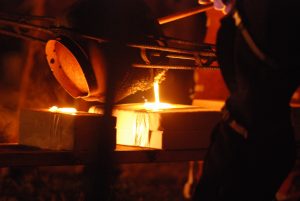
Steel is one of the world’s most versatile materials. Defined as an alloy of iron and carbon, it’s both strong and durable. Furthermore, over two-thirds of all steel produced in North America is recycled annually, according to the American Iron and Steel Institute. To make steel, however, metalworking companies must perform several steps involving the use of raw iron.
Why Steel Requires Raw Iron
All steel is made using raw iron. As previously mentioned, steel is characterized by the presence of iron and carbon. The ratio of these two elements varies depending on the specific type of steel being made. With that said, most types of steel contain about 1% carbon and 97% iron, with the remaining 2% consisting of trace elements and impurities.
The amount of carbon will affect the steel’s physical properties. Generally speaking, the greater the concentration of carbon, the stronger and harder the steel is. With that said, adding too much carbon to steel can make it susceptible to rust and corrosion while also making it difficult to weld and form.
Smelting Raw Iron
Whether it’s low-carbon, medium-carbon or high-carbon, the first step to producing steel involves smelting raw iron. After the iron ore has been mined and harvested, it’s smelted in a large furnace. It’s not uncommon for these furnaces to achieve temperatures of over 3,000 degrees Fahrenheit. As the iron heats up and liquefies, it separates from its impurities, thereby creating cleaner iron that’s better suited for the production of steel.
Adding Carbon
When smelting raw iron with the goal of producing steel, metalworking companies will also use this opportunity to add carbon. Carbon, of course, is essential to the process. It distinguishes steel from raw iron, resulting in greater strength and durability. As the raw iron turns from solid to liquid, a specific amount of carbon is added.
Adding Limestone
In addition to carbon, metalworking companies will also feed limestone into the furnace when producing steel. Both carbon and limestone are essential to the steel-making process. Limestone is used to remove impurities, including flux, by helping the iron separate from the impurities.
In the past, producing steel was a painstakingly tedious and difficult — as well as dangerous — process. Thanks to recent advancements in the field of metalworking, though, companies can produce significantly more steel in less time. A typical blast furnace can convert nearly 400 tons of iron and carbon into steel in just 40 minutes. Hearth furnaces can produce similar volumes of steel but require a greater length of time.
No tags for this post.